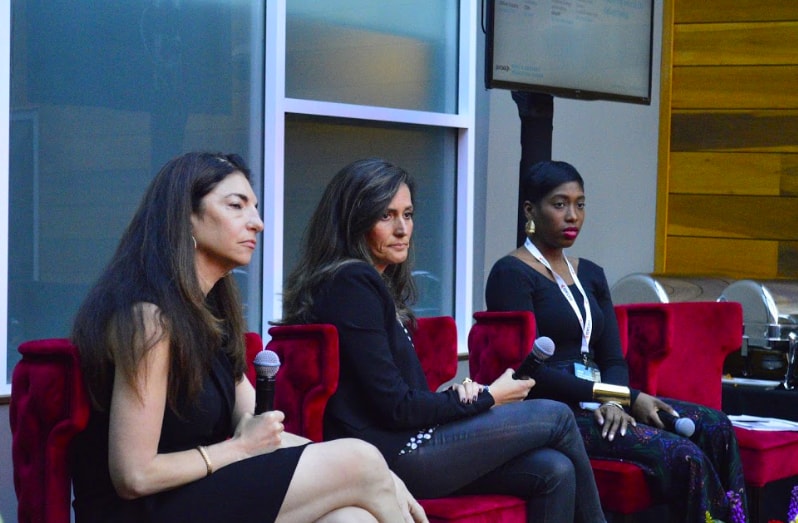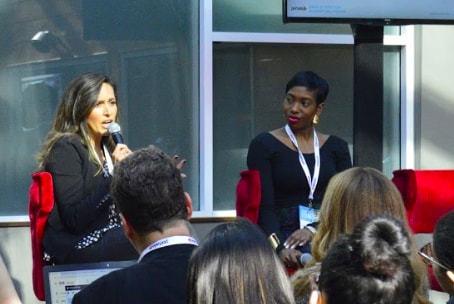What: CNN’s Robin Garfield, Tecate’s Belen Pamukoff, and GroupM’s LaToya Christian kicked off the Portada Data and Content Marketing Forum with a panel titled How Data and Content Continue to Fuel the Evolving World of Advertising.
Why it matters: With 2.5 quintillion bytes of data created each day and 90% of the world’s recorded data being created in the last 2 years, the need to understand data is quite apparent.
By Dane C. Rogers

Wednesday’s Portada Data and Content Marketing Forum kicked off with a panel discussion on How Data and Content Continue to Fuel the Evolving World of Advertising. CNN en Español Anchor and Correspondent Guillermo Arduino moderated the panel which was composed of the following representatives from the network, brand, and advertising media agency areas: Robin Garfield, SVP of Research and Scheduling for CNN, who oversees consumer research and audience analysis in order to schedule programming for various channels and platforms across the network. Belen Pamukoff, Brand Director for Tecate (Heineken), specializes in building healthy brands and improving sales performance. LaToya Christian, Managing Partner, Marketing and Analytics at GroupM, has a 10-year track record of creating and implementing brand strategies for high-impact marking campaigns for various Fortune 500 companies (Target, Google, Unilever, NBCUniversal, and others).
CNN en Español and Portada will partner up again at Portada Miami to offer yet another perspective on the question addressed here. Christine Esteve, VP E-Commerce, Carnival Cruise Lines; Andrew W. Russo, VP Data Science, Starmark; Ana Crandell, Group Account Director, OMD Multicultural; and Seth Holladay, VP of Digital Research & Analytics for CNN will explain how content influences commerce and analyze how data determines their content strategies.
The question-and-answer format brought up a variety of topics that led to an illustrative discussion of the key issues facing media marketing professionals.
With 2.5 quintillion bytes of data created each day and 90% of the world’s recorded data being created in the last 2 years, the need to understand data is quite apparent.
The first major question was: When you look at content and data what comes to mind first? From the network perspective, Robin Garfield said CNN considers data, “What people are watching, which platform they are coming from, and where they are going next. We use that information to program on a real-time basis and also over the long-term, to build products and programming to meet those demands.”
Belen mentioned that data is used in a two-part process to carry out a brand’s strategy. Brands can use data to first, make a message more relevant and, second, to inform that strategy of how to deploy and distribute its content to an audience.
 LaToya shared the statistic that 62% of marketers feel that there is too much data out there and they don’t know where to start. The key is to “remember that each data point is an interactive event in which consumers are telling us their preferences” and reiterated the important to “humanize the data.”
LaToya shared the statistic that 62% of marketers feel that there is too much data out there and they don’t know where to start. The key is to “remember that each data point is an interactive event in which consumers are telling us their preferences” and reiterated the important to “humanize the data.”
When asked about how a news organization weighs discovering the truth with creating targeted content, Robin mentioned the importance of understanding that consumers are people first, and that delivering the news and information that people care about is core to the brand. CNN has been able to couple its user data with surveys and focus groups in order to figure out the interests of its audience to best present the most relevant facts.
LaToya reiterated the question that often arises, Whether data stifles creativity? Her belief is that “data and content live together and fuel one another.” She explains that data is able to present concrete facts that drive engaging stories. It can fuel opinions and grounds vibrant discussions in reality.
Also read CNN en Español: What Are the Ways Data Can Fuel the World of Advertising?
Robin added that in her experience, “people love to geek out on data,” especially when it comes to polling and tracking data involving political coverage. In fact, the consumers who really love data often move from television to digital platforms and those multi-platform consumers spend the most total time interacting with CNN, and are the most attractive to advertisers.
Belen opened up about some of the shortcomings of the data available to an alcohol brand that knows its customers primarily through their spending patterns. There are certain limitations that come from the absence of on–line shopping information, and the data Heineken gets is primarily where its Tecate customers shop and their zip codes. The brand knows it is playing without a full deck, as many suppliers are unwilling to share their sensitive customer data.
Belen also mentioned the importance of understanding the level of diversity that exists within the hispanic audience. A major distinction exists between acculturated and un-acculturated Hispanics, the former who may not even speak Spanish may respond to different tactics than those totally immersed in Hispanic culture. These differences are not often seen on paper, and many decision-making executives only know of the “power of the hispanic market” but oftentimes fail to understand the intricacies of the segment itself. Explaining those differences can sometimes be challenging to non-Hispanic managers. “Even within the LA market, there are significant differences between those who identify as chicanas vs cholos.”
Data, Content and Privacy
A hot topic for any consumer. Latoya said that as she considers things from both the customer and the marketer side, the importance is for those with access to data must act ethically with it, and those questions are being asked more frequently from consumers.
Robin presented the notion of a data exchange, an unwritten contract that exists between consumer and marketer. People will remain willing to share data, provided that a good value proposition exists for the consumer. She made the analogy of a patient being willing to share their health information if it could potentially save their life or offer better treatment. Marketers, too, should offer a benefit.
The panel ended with the major topic of granularity and the quest for a common currency when dealing with Hispanic audience measurement. LaToya said that while granularity may be important, there will always be gaps in data unless a multi-source approach can be reached. As for a common currency of data, Belen believes that it probably cannot be achieved, due to the complex nature of the audience. LaToya said that from a large marketer perspective, because trying to segment the market with only one data source is generally ineffective, it is unlikely that we will ever see one.
[ctalatinb_es]







